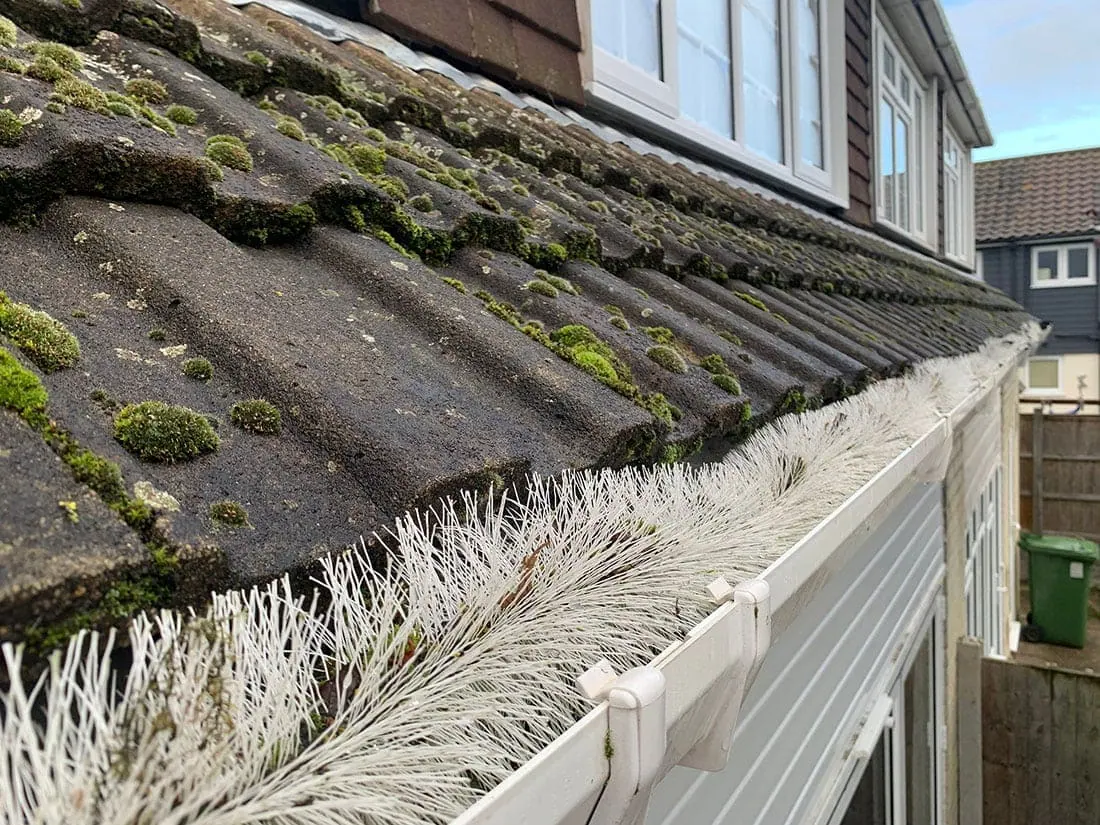Gutter guard maintenance | They’re not a trouble-free option
Homeowners often believe that gutter guards help to reduce the amount of debris falling into their gutters and blocking downpipes. But, installing gutter guards doesn’t necessarily solve the problem. Nor does it mean that you should neglect regular gutter maintenance – far from it.
If you do, it can lead to blockages of stagnant water sitting in your gutter or downpipe, which will eventually build up and overflow. This can lead to more severe damages such as water ingress, damp and rotting timbers.
In this knowledge article, our experts investigate gutter guard maintenance to ensure you make the right decision for your property. They will discuss whether gutter guards are worth the maintenance, who should carry out the maintenance, and useful tips for keeping your gutters and downpipes clear and draining efficiently.

Are gutter guards worth the maintenance?
Gutter guards are designed to prevent debris from clogging gutters and downpipes, and allow the free flow of water. But, many homeowners don’t realise that gutter guards can simply move the build-up of debris to another area of your gutter – building up on top of the guard, rather than inside the downpipe.
In fact, making sure that you maintain gutter guards is just as important as cleaning out your gutters. As soon as you see a collection of debris on the surface, you’re at risk of this build-up causing problems.
Pros and cons of gutter guards
On a positive note, gutter guards should prevent debris from entering your downpipes, which is a common cause of blocked drains. Plus, it’s much harder to clear clogged gutters when the blockage is located in a sealed downpipe, as opposed to where the debris settles on your gutter guard. This provides a certain level of drainage protection.
However, not performing gutter guard maintenance regularly can actually encourage water build up at a greater rate and quickly lead to overflowing gutters. While the actual gutters can be vacuumed or hosed, gutter guards often require physical removal, cleaning, and reinstallation. Arguably, this is more effort than cleaning the gutters themselves. Plus, debris is likely to build up at a faster rate on your gutter guards than when you don’t have them, as the debris isn’t flowing through your downpipes.
Why do you need to have a good flow rate in your gutters?
If water comes into contact with building fabric, it causes problems. Plus, the saturated build-up of debris adds weight to your gutter, and this can open up joints, loosen fixings and detach screws from fascia boards, for example. Regular cleaning and inspection of your gutter guards can help to mitigate these problems. If a poor rainwater drainage flow rate is left unmaintained, it can result in other costly repairs.
Blocked gutters can lead to internal damp issues if brickwork or timbers are in direct contact with water.
How often do I need to maintain gutter guards?
Remember, gutter guards are not a maintenance-free option and as mentioned, you will need to clean them frequently. Their level of maintenance depends on the type of gutter guards installed, whether there’s a large amount of tree coverage near your residence and whether they’re north-facing. This is because moss can build up quickly in shadowed areas and holds water to create additional weight on your gutters, often leading to problems.
Types of gutter guards and their maintenance needs
Various types of gutter guards exist on the market, each with unique maintenance requirements. Mesh, hedgehog/brush and balloon gutter guards are some of the most common types, so understanding the specific maintenance needs of each one is essential for ensuring the longevity and effectiveness of your gutter guard system.
Hedgehog gutter brushes
A hedgehog gutter brush is a long bristle brush that can be secured into the gutter using special gutter clips or zip ties. For maintenance, remove and clean gutter guards with a garden hose and scrubbing brush when build-up is evident. Dispose of the dirt and debris properly, then reinstall the brush in the gutter. The brush typically lasts five to seven years before needing replacement.
Mesh gutter guards
Mesh gutter guards are mesh coverings that are placed on top of gutters. Regular inspection and cleaning are essential to stay on top of debris that settles at the top of the guards. As with hedgehog gutter brushes, these should be washed on ground level and reinstalled. If moss, soil or light debris has accumulated below the mesh, pressure cleaning may also be necessary.
Balloon gutter guards
Balloon gutter guards are little balloon or bucket-shaped devices placed into the opening of a downpipe. They should be removed and washed every six months to clear any build-up. This involves removing the guard from the downpipe, washing it thoroughly and reinstalling it. Balloon gutter guards are typically durable and don’t need regular replacement unless they are of poor quality.
Gutter guard maintenance: DIY or professional?
If your property has two storeys or more, complex gutter systems or damaged or worn gutters to contend with, a professional gutter cleaning service should be called for as much as twice a year.
If your gutters are located on the first storey of a property, gutter guard maintenance can be completed at home. But, as well as being labour-intensive and physically strenuous, there are multiple other factors to consider:
Heights – Are you comfortable working with heights and will you have a second person to spot you to prevent dangerous falls? Gutter guard cleaning using ladders is a two-person job, without proper safety equipment.
Skills – Do you know what you’re looking for in terms of damp or warning signs when you’re looking at the gutter, and have the tools and skills required to carry out the gutter guard maintenance?
Equipment – As well as the right gutter cleaning tools, do you own the personal protective equipment (PPE) to wear, such as safety glasses to keep debris from falling in your eyes, cut-resistant gloves to keep your fingers safe from sharp edges and sturdy footwear? In addition, are you at risk of damaging your gutters by constantly propping ladders up against them?
Even if it’s safe to carry our gutter guard maintenance yourself, calling a professional is often still the most sensible choice for maintenance. Professionals not only have specialist tools to clean gutters, but they also have the expert knowledge to carry out the job safely, quickly and effectively.
If you’re thinking about installing gutter guards, consider where you will install them, too. Don’t install them above conservatories where access will be difficult, even with a ladder. Instead, rely on technologies such as a telescopic gutter cleaner or vacuum cleaner. Truthfully, gutter guard maintenance can be more hassle and more expensive when compared to maintaining gutters without the guards.
Tip: Our experts use SkyVac vacuum cleaning to reach gutters without using a ladder for cost-efficient gutter cleaning.
Manual gutter guard cleaning and maintenance
If you’re still determined to install gutter guards, then do so carefully. Around 515 injuries happen from ladder falls every year*. As we’ve touched on, be sure to take the gutter guards down for cleaning on the ground, rather than doing it at height where there is more risk. It might sound obvious, but make sure that you know how to reinstall them, too! Truth be told, once you’ve taken the gutter guards out, you might decide you need to clean your gutters anyway…
Should I invest in gutter guards?
To summarise, gutter guards might reduce the likelihood of blockages in your downpipe, especially if you have heavy tree coverage around your property. But truly, they are far from a maintenance-free solution. Whether you decide to invest in gutter guards or continue to invest in getting your gutters cleaned, we hope this guide has armed you with the knowledge to make an informed decision.
Book an expert roofer

Our roofing experts are on hand for gutter maintenance and repair advice.
- Half-hour rates from £42.75 + VAT
- One hour minimum
- £10 off when you book online
- Free estimates for planned work
Areas we cover

We have expert roofers who cover the whole of Greater London and the South East of England.
We can schedule any type of roofing work in Berkshire, Buckinghamshire, Cambridgeshire, East Sussex, Essex, Greater London, Hertfordshire, Kent, Surrey, and West Sussex.
If you are outside of this coverage area, we may still be able to assist you. Our scheduling team will check availability for your location. Call or submit a callback request, and a member of our team will be in touch with you.
Was this article helpful?
Think we could improve this article? Please let us know